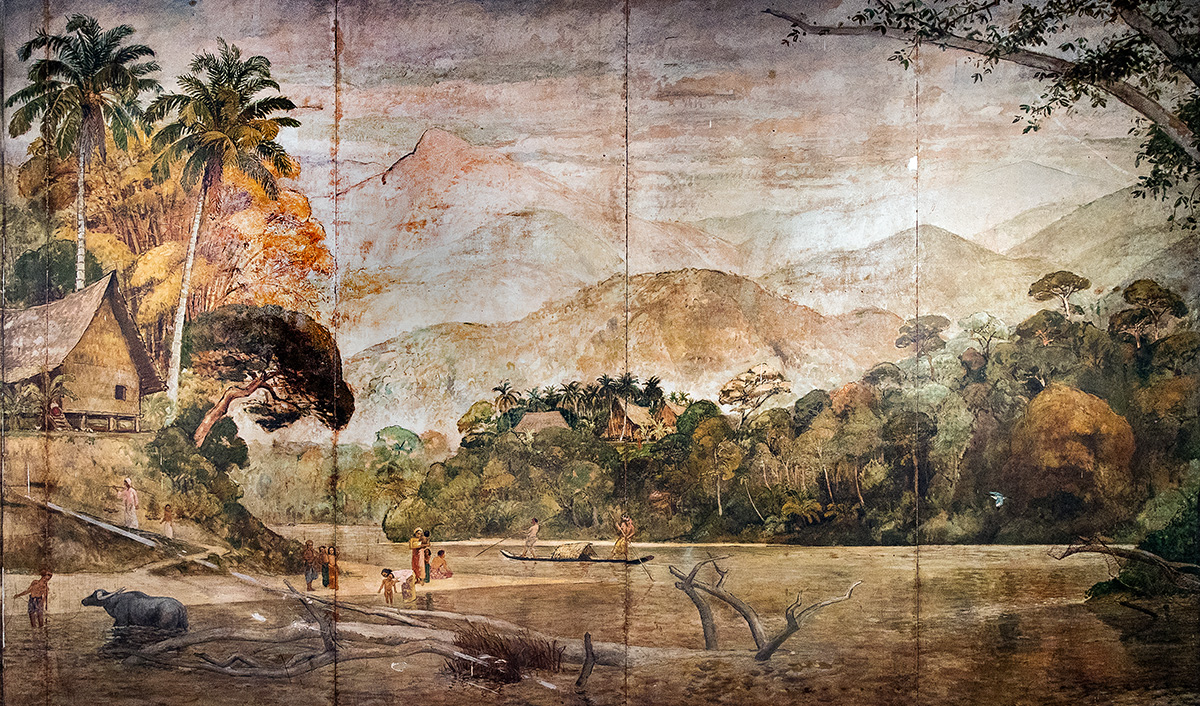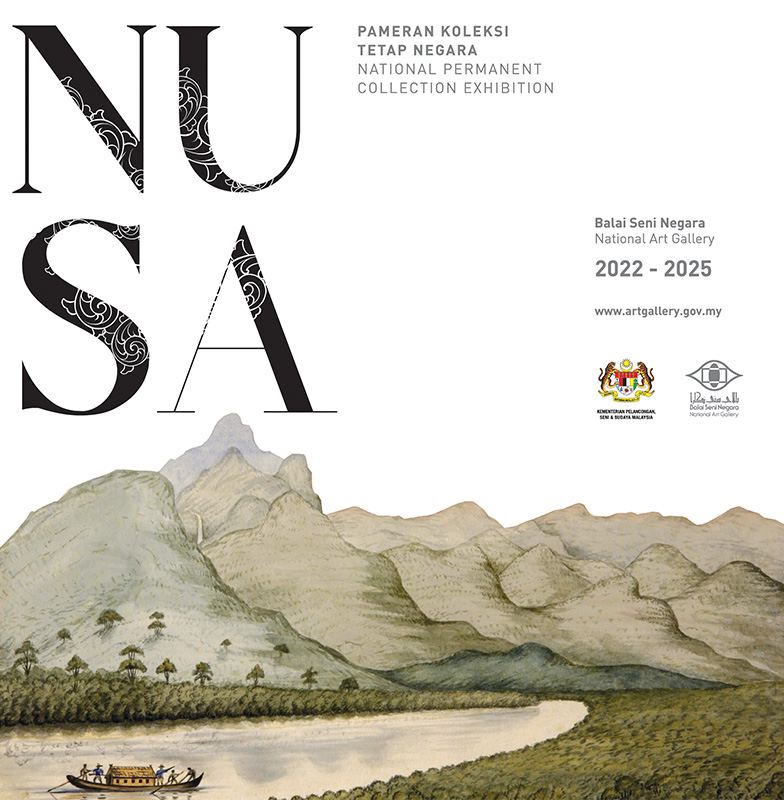

Dinding Potret Kanta
2014 - 2017
Hand print on silver resin coated paper, food cans, mounted on oxidised zinc panel
After a series of extensive renovations which began in August 2020, the National Art Gallery is thrilled to re-open its doors in mid-May 2022, with a stellar line-up of exhibitions both onsite and online for everyone to revel in." — YBhg. Dato' Indera Dayang Fatimah Tom Abang Saufi, Chairperson, National Visual Art Development Board (NVADB)
The National Art Gallery reopens this month after undergoing a panoptic refurbishment that began in August 2020. These overhauls include a brand-new grey asphalt roof, and to give viewers an all-encompassing gallery experience, the seven main galleries (Reka, Tun Razak, 2A, 2B, 3A, 3B and Portrait Gallery) have been further enhanced by an all-new Gift Shop, Cafe and fully-equipped Art Hospital.
The National Art Gallery, affectionately known to Malaysians as Balai, is set to woo art enthusiasts with a selection of specially curated exhibitions — NUSA, SINGLE and digital art exhibition WALKING THROUGH A SONGLINE, to name just a few.
NUSA
Conceived last year as a main entry point to 2022, NUSA — shown in Reka, Tun Razak, 2A, 2B and 3B — encompasses over 400 works taken from the National Collection and highlights across-the-board segments that include historiography, mythology, superdiversity social fabric and local wisdom. NUSA explores impressions in relation to superdiversity within the country's and regional contexts, is curated to render an enthralling cognitive content to visitors, and emphasises visual percepts of relevancy, conservation, interactivity and digitisation.
The selection of works will include masterpieces imbued with the idea of NUSA, such as River Pergau State of Kelantan, painted in the 19th century by William Samwell; Kampung Nelayan (Fishing Village), a distinguished Chinese brush painting by Chung Chen Sun that was categorised as a National Heritage under the National Heritage Act 2005; an iconic compendium by pioneers Latiff Mohidin, National Laureate Syed Ahmad Jamal, Redza Piyadasa and Chuah Thean Teng; and the most recent acquisition, a contemporary interpretation of Enrique de Malacca Memorial Project (2016) by Ahmad Fuad Osman.
SINGLE
A nod to accomplished young contemporary artists who have created high-impact and solid bodies of work from arresting and monumental perspectives, and contributed significantly at both the national and international levels, SINGLE highlights new works spanning sculpture, mixed media, installation and two-dimensional offerings. This year, the three artists who have been selected for SINGLE are Shafiq Nordin, Red Hong Yi and Saiful Razman.
To be displayed at the National Art Gallery's main lobby, these works are meant to “greet” visitors, welcoming them to an exciting year ahead. This exhibition also serves as a platform for research and dialogue and will be accompanied by supporting programmes. SINGLE will make its debut in mid-May and concludes in January 2023.
WALKING THROUGH A SONGLINE
Organised by the National Museum of Australia and Mosster Studio with the National Art Gallery, this collaboration — with support from traditional Aboriginal custodians, The Australian High Commission, Australian Government and Australia Now Program — is an immersive digital art exhibition celebrating Australian indigenous arts, culture and innovation.
WALKING THROUGH A SONGLINE is a pop-up multi-media experience based on a component of the National Museum of Australia's internationally acclaimed exhibition Songlines: Tracking the Seven Sisters. This ground-breaking show follows in the tracks of the Seven Sisters Tjukurrpa (Dreaming) across the Western and Central deserts of Australia as they escape their pursuer. Curated by Professor Margo Neale, head of the New Centre for Indigenous Knowledge and the indigenous curator and principal advisor to the director at the National Museum of Australia, Neale is a co-recipient of seven Australian Research Council grants in collaboration with the Australian National University, Yale University and the University of Victoria.

Lukisan Lama Heritage Station Hotel, Stesen Keretapi Tanah Melayu Bhd c.1940
Oil paint on masonite wood
ART HOSPITAL
Collection and conservation is one of the core business interests of the National Art Gallery. Under the National Visual Arts Development Board Act 2011 (Act 724), the institution aims to be the leading repository of the national art heritage that collects, conserves, maintains, exhibits and promotes art and inculcates awareness, understanding and appreciation of art.
After more than 60 years, the practice of collecting art has witnessed an exponential growth in the number of artists and collectors in private and public galleries and educational institutions throughout the country. Inspired by this evolution, the National Art Gallery formed ART HOSPITAL (National Art Repository and Conservation Centre) to provide consultation, preventive and curative conservation, artwork condition reports, material research and art storage.
Approximately 3,000 artworks of the National Collection are kept under controlled room temperature at the Repository of Artworks on Paper and 1,500 paintings in various mediums are stored in the Painting Repository.
Providing top-notch art conservation services and storage facilities for collectors and artists being the main core businesses of ART HOSPITAL, conservation of paintings is undertaken by highly-experienced staff of the National Art Gallery’s Collection and Conservation unit. In the 348 sq m state-of-the-art lab facilities, treatments such as cleaning, tear repair, image reintegration and lining are carried out. The lab is equipped with instruments like polarised light microscope and X-ray fluorescence, which are useful for more detailed conservation works.
A total of 160 sliding shelves, each measuring 10ft x 11ft, are provided to store art belonging to collectors and artists. Each artwork is stored here in accordance with the terms and conditions of the artwork repository rental agreement and protected by insurance at a certain fee.
The National Art Gallery will also announce the winners of The Young Contemporaries award (Bakat Muda Sezaman BMS21) during its official opening. This prestigious and highly coveted competition, which began in 1974, was won by Zulkifli Mohd Dahalan with his seminal entry Halaman Rumah Kami. In 2019, Samsudin Wahab took home the main prize with his epochal installation Rambu-Rambu Memori. Since 2000, the National Art Gallery has held the competition biennially, and for its 26th edition, a new concept was introduced to fit into the pandemic situation. Art on Site (Seni di Lokasi) gives artists the autonomy of creating works in all states across the country, resulting in voltaic alternative exhibition spaces. Artworks of participants will not be displayed at the National Art Gallery but instead at their chosen venues — this format allows for virtual locations such as links, portals, applications, animated works, performing arts and so much more. Apart from two main awards, The Young Contemporaries 2021 will mete out additional prizes, three each for Visitors’ Choice Online and Visitors’ Choice on Site.
Another exciting introduction to the new Balai is the Hybrid Space, situated in the lobby of the administration building, where art industry players are given the freedom to showcase their works digitally. The National Art Gallery equips the artists with televisions and projectors, enabling them to display and promote their art while engaging potential buyers. This is in line with the gallery’s mission to merge art with the latest trends.
Established in 1958, the National Art Gallery is one of the oldest art museums in Southeast Asia and houses one of the largest collections — totalling over 4,500 pieces of artworks — in the region. It has held numerous exhibitions since its inception, featuring selections from its permanent collection and the National Collection, which has been entrusted to the museum.
The National Collection is a large repository of visual information encompassing all aspects of human endeavour. Built over the last six decades, the collection has not only developed into a body of knowledge that is uniquely local, but one that is characteristically regional as well, given Malaysia's position in the heart of Southeast Asia, a sprawling region with a long history of migration and which is home to various Asian cultures. The term "superdiversity" may apply not only to the multiethnic population of Malaysia or the peoples of Southeast Asia, but to the aesthetic aspirations found in the works in the National Collection.
National Art Gallery director general Ameruddin Ahmad sums it up. "We strive to achieve certain goals with our permanent exhibition: the diversity of this art collection is seen from all scopes of art producing intentions — artistic expressions, visual narratives, rituals, functions and persuasions. It's also about repositioning the art collection in the exhibition other than the initial reasons it was conceived. It is to create a new meaning and, most importantly, to make it still relevant to people who view it now."
URL link : https://www.artgallery.gov.myen/homepage/
- BYD unveils battery system that charges an EV in five minutes
- MRCB, Sapura Energy, Solarvest, Salcon, Rohas Tecnic, HHRG, Jentayu, Focus Point, Catcha Digital, Poh Huat, Dutch Lady, AmanahRaya REIT
- MACC chief says Ismail Sabri has a lot to answer to, vows thorough probe
- Loke: Malaysia to receive two ETS train sets from China next month
- Jentayu Sustainables’ Sabah hydro asset acquisitions mutually terminated
- Creative Technology cuts workforce, adding to global wave of tech layoffs - report
- Pimco turns more negative on German bonds ahead of debt vote
- Volkswagen's Audi to cut 7,500 jobs in administration, development by 2029
- Asia Poly disposes of entire stake in Ta Win
- OECD warns of tariff drag on growth as Trump vows to press on with levies

